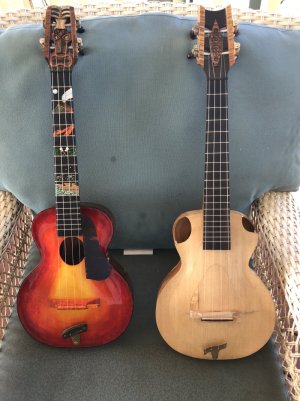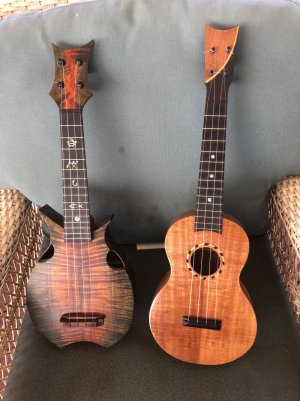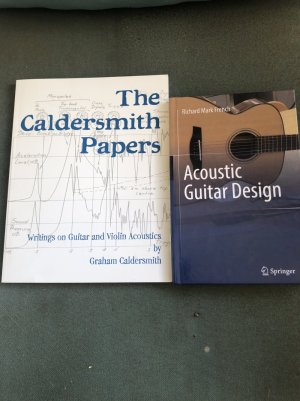You are using an out of date browser. It may not display this or other websites correctly.
You should upgrade or use an alternative browser.
You should upgrade or use an alternative browser.
A Couple New Books
- Thread starter BuzzBD
- Start date
Nathaniel Rich
Member
Thanks for sharing Brad, I just received the “Mastering the Sound of the Acoustic Guitar” which is very useful. How do these compare. Is there as much practical application for the builder.For those of you with an interest in the technical side of acoustic instruments, here are a couple of new books I received today. Both published in 2022, I have just had a chance to skim through them, but they both appear excellent. Let me know if I can answer specific questions.
Brad
View attachment 155762
BuzzBD
Well-known member
Hey Nathaniel, nice to hear from you. I think that these books compliment Mastering the Sound nicely. CalderThanks for sharing Brad, I just received the “Mastering the Sound of the Acoustic Guitar” which is very useful. How do these compare. Is there as much practical application for the builder.

 smith offers some historical perspective on his thoughts a couple of decades ago. French is very up to date, exploring and comparing many different builds and concepts. He has a section on sound hole size vs. body volume, which dovetails nicely with some of my latest discoveries. I have found that the sound hole/ side port shape and placement make a big difference in the body resonance frequency. The pictures below show two sets of similar ukulele. Two are similar tenor archtop ukulele and two concert flattop ukulele. The body resonance of archtop with the conventional oval hole and side sound port is A3 -10 cents. The other archtop with the combination of two sound hole/ side ports on either side of the neck has a body resonance of F3 -08 cents. The conventional flattop phase a body resonance of A3 -18 cents and the ipu shape has a resonance of F sharp 3 -20 cents. The sound pressure levels of the ukulele are similar, but not surprisingly the timbre of the two with the new sound hole design is darker.
smith offers some historical perspective on his thoughts a couple of decades ago. French is very up to date, exploring and comparing many different builds and concepts. He has a section on sound hole size vs. body volume, which dovetails nicely with some of my latest discoveries. I have found that the sound hole/ side port shape and placement make a big difference in the body resonance frequency. The pictures below show two sets of similar ukulele. Two are similar tenor archtop ukulele and two concert flattop ukulele. The body resonance of archtop with the conventional oval hole and side sound port is A3 -10 cents. The other archtop with the combination of two sound hole/ side ports on either side of the neck has a body resonance of F3 -08 cents. The conventional flattop phase a body resonance of A3 -18 cents and the ipu shape has a resonance of F sharp 3 -20 cents. The sound pressure levels of the ukulele are similar, but not surprisingly the timbre of the two with the new sound hole design is darker.Brad
Last edited:
rmmottola
Member
- Joined
- Dec 11, 2021
- Messages
- 24
- Reaction score
- 32
I concur that these two books are excellent! The Caldersmith book is a complete collection of the late scientist and luthier's published work, put together by luthier and author Graham McDonald. These are primarily original research papers and are generally accessible to folks experienced in reading such papers. Graham Caldersmith was an early influence for me. His explorations into different size guitars were real eye openers. BTW I wrote a detailed review of this book, which appeared in American Lutherie #148. The French book is the author's latest, I believe it is his third on the general topic of guitar technology. His books trend more accessible, while retaining technical detail. Although the earlier books I would recommend enthusiastically to readers with technical backgrounds, this one I would recommend to anyone wanting a more complete technical understanding of how instruments work. Full disclosure: I provided editorial input on this book. Graham McDonald and Mark French provided editorial input on my latest book.
Pete Howlett
Well-known member
Guitar technology - useful but you have to interpret it. A ukulele is not a guitar and it behaves differently when plucked and more importantly, you want it to behave differently.
Nathaniel Rich
Member
Thats interesting, Do you know why the new design raises the body resonance from A3 to F3? Placement of the sound holes is not dissimilar from a slack key guitar design.Hey Nathaniel, nice to hear from you. I think that these books compliment Mastering the Sound nicely. CalderView attachment 155818View attachment 155819smith offers some historical perspective on his thoughts a couple of decades ago. French is very up to date, exploring and comparing many different builds and concepts. He has a section on sound hole size vs. body volume, which dovetails nicely with some of my latest discoveries. I have found that the sound hole/ side port shape and placement make a big difference in the body resonance frequency. The pictures below show two sets of similar ukulele. Two are similar tenor archtop ukulele and two concert flattop ukulele. The body resonance of archtop with the conventional oval hole and side sound port is A3 -10 cents. The other archtop with the combination of two sound hole/ side ports on either side of the neck has a body resonance of F3 -08 cents. The conventional flattop phase a body resonance of A3 -18 cents and the ipu shape has a resonance of F sharp 3 -20 cents. The sound pressure levels of the ukulele are similar, but not surprisingly the timbre of the two with the new sound hole design is darker.
Brad
Nathaniel Rich
Member
I think books like this are incredibly useful. Ukulele repertorie is quickly expanding with players wanting different sounds ands and colors from their instruments. I agree the traditional sounds should not be mimicking a guitar however its nice to have knowledge to draw from that allow use to make them sound anyway we want.Guitar technology - useful but you have to interpret it. A ukulele is not a guitar and it behaves differently when plucked and more importantly, you want it to behave differently.
Cheers,
Nathaniel
Pete Howlett
Well-known member
Of course. The are those who want a ukulele to sound like a guitar and vici versa
BuzzBD
Well-known member
One of the great little nuggets in Caldersmith’s book is where he is looking back and comparing his ideas from 1982 to the present year of 1999. He concludes that many honest attempts by luthiers to improve the sound of guitars will in fact not be accepted as such by musicians.
BuzzBD
Well-known member
Aloha Nathaniel, your instincts are correct in this case, there is clearly more going on. The main impetus for my experimenting with this stems from an article I recently read on research on violin f holes. To paraphrase their conclusion, they stated that the majority of air movement occurs next to the edge of the sound hole. Thus sound hole with elongated shapes are more efficient enabling the instrument body in acting as an air pump. To put this to the test, I combined the sound holes and side ports and elongated the shape to resemble a football. An interesting byproduct of this is the calculation of the practical area of these sound holes is now an interesting mathematical exercise. I know from experience that there are three ways to adjust the body resonance of an instrument. You can thin the top/ back, which will lower the frequency. Or you can enlarge the sound hole (Helmholtz), which will raise the frequency. Clearly by changing the shape and position of the sound holes, I have altered how the top vibrates. My intention was to enlarge the top area of the monopole mode, thus lowering the frequency. I am used to seeing tweaks like these resulting in frequency changes of 10-20 cents not multiples of semitones. Just starting down this rabbit hole, more to follow.Thats interesting, Do you know why the new design raises the body resonance from A3 to F3? Placement of the sound holes is not dissimilar from a slack key guitar design.
BuzzBD
Well-known member
As a follow up to my last post, I have just read an article by R. M. Mottola on the Helmholtz Resonance in volume 7 of the GAL’s Big Red Book. It offers some further insight as to the variables involved.
Brad
Brad
erich@muttcrew.net
Well-known member
Side note on Mottola's work: He has an online journal, the Savart Journal, with articles on lutherie by various authors, some very technical.
At his website liutaiomottola.com he also has a free tool, the "G" Thang, for parametric design of guitar (or ukulele) body shapes - for Windows only however. We've used this tool to finalize the design for many of our instruments.
At his website liutaiomottola.com he also has a free tool, the "G" Thang, for parametric design of guitar (or ukulele) body shapes - for Windows only however. We've used this tool to finalize the design for many of our instruments.
Similar threads
- Replies
- 1
- Views
- 453

